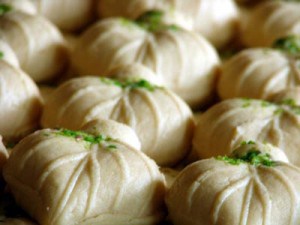
In this blog series, Molly will be (virtually) traveling around the globe to explore the way cheeses are enjoyed and incorporated into different cuisines. Some of these cheeses and methods might seem familiar, while others might be completely new to you. Last week, we talked about the Iceland and the importance of Icelandic sheep and cows. Read on to find out how you can win a free copy of culture! Get more stamps on your cheese passport and join us for a historical and cultural adventure!
When considering Indian cuisine, cheese probably isn’t the first thing you think about. Though India is the largest producer of of milk and milk products in the world, the country does not boast the wide variety of cheeses that some European countries have. Most of the dairy consumption in this country happens in the form of yogurt, but non-melting paneer is the most popular choice when it comes to cheese. It is similar to an unsalted, pressed ricotta.
It’s hard to believe that some cheeses won’t melt, but paneer falls into that category because of how it’s made. This “farmer’s cheese” is produced by curdling heated milk with lemon juice or another acidic liquid, then the curds are drained to remove excess liquid. In Northern India, it is also called chhena, and is made from the milk of water buffalo. Paneer is very easy to make at home, and The Kitchn has a great step-by-step recipe for guidance. With only 30 minutes and a few basic kitchen tools, you will be well on your way to a delicious curry or kebabs.
Paneer does not melt because of its high acidity level, which alters the chemical composition of the cheese. This unsalted cheese is very popular both sweet and savory applications. Dishes such as paneer tikka swap out chicken for the cheese, making it vegetarian. It can also be used in curries, or in desserts such as sondesh, that are flavored with simple syrups.

Sondesh from West Bengali flavored with date sugar | Photo credit: Image courtesy of Wikipedia
Traditionally paneer has been made by hand, however cheese producers in India have started to market and sell the product to consumers, as the cheese industry tries to expand. Greater international exposure of cheeses in India that are traditionally European have increased demand in the country for niche cheese products. Cheese consumption continues to be an urban phenomenom though, and it is not a staple of the mainstream adult diet like it is in some other countries.
Most of the cheese produced in India comes from Amul (Anand Milk Union Limited), a dairy cooperative. The cheese is mostly marketed and sold for domestic consumption. Amul does export their Malai Paneer to the Middle East and North America. Importing cheese also requires jumping some hurdles, such as the high cost of shipment due to the lack of cold chains in the country. Consumers also prefer cheaper, local brands that suit their palates better than imported products.
The cheese culture of India is still expanding, and it will be interesting to see how further globalization of markets affects the cuisine and cheese consumption in the country.
What’s your favorite way to eat paneer? Have you tried your hand at making your own? Tell us about it in the comments below for a chance to win a copy of our summer issue! Comments must be posted by 11:59 p.m. EDT on Tuesday, August 5, 2014, to be eligible to win. So comment today and stay tuned for next week’s post, when we travel to China!
Photo Credit: Featured image of man making paneer courtesy of 3 Wheeled Cheese





Panir Tikka also Palak Paneer is great curry.
Great idea!
The major health benefits of cheese include relief from hypertension and osteoporosis. It also helps in maintaining bone health, gaining weight and dental care.
Great tips!
What can’t cheese do?!
i love recipes which made with cheese specially paneer tikka and malai paneer thanks for this post.